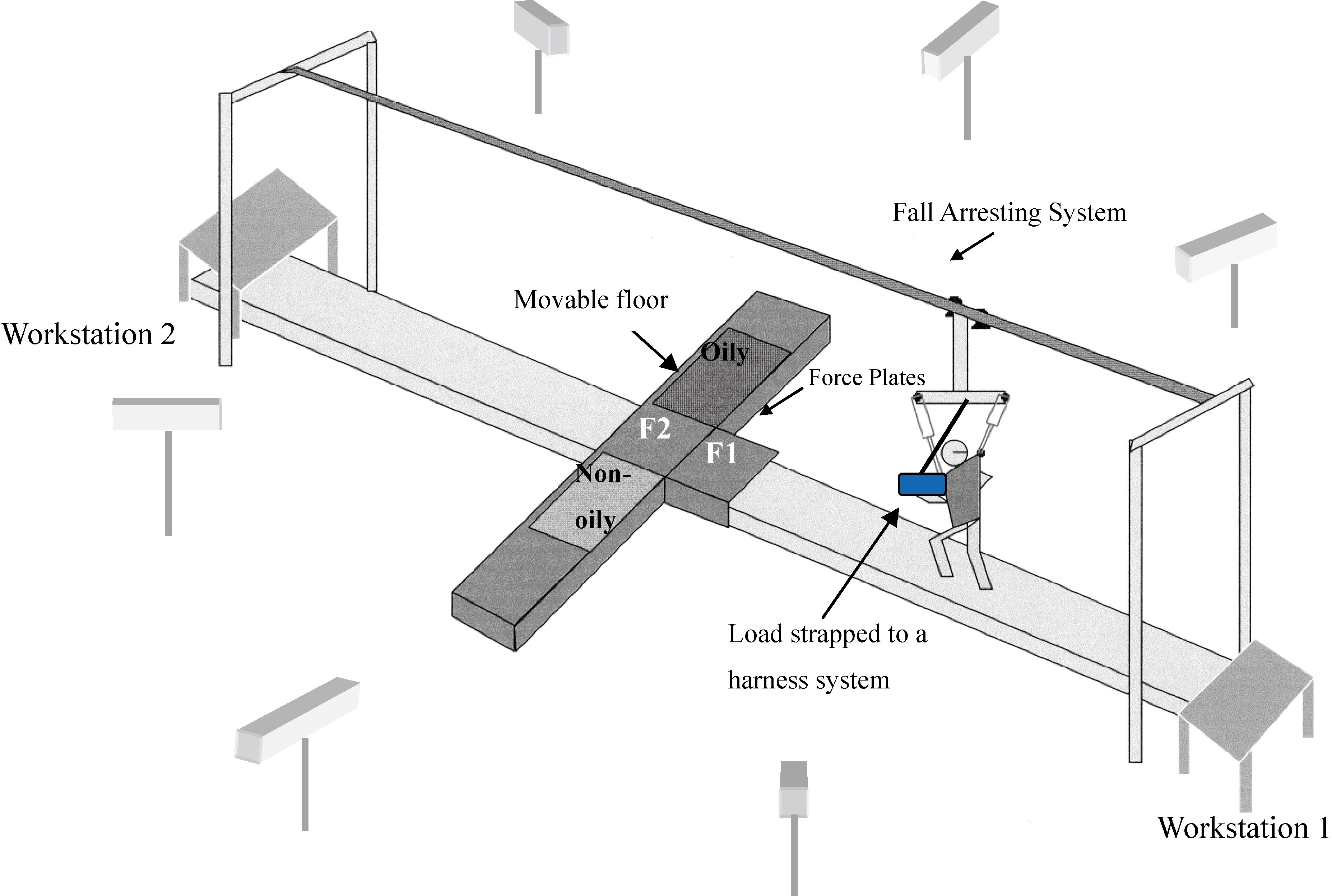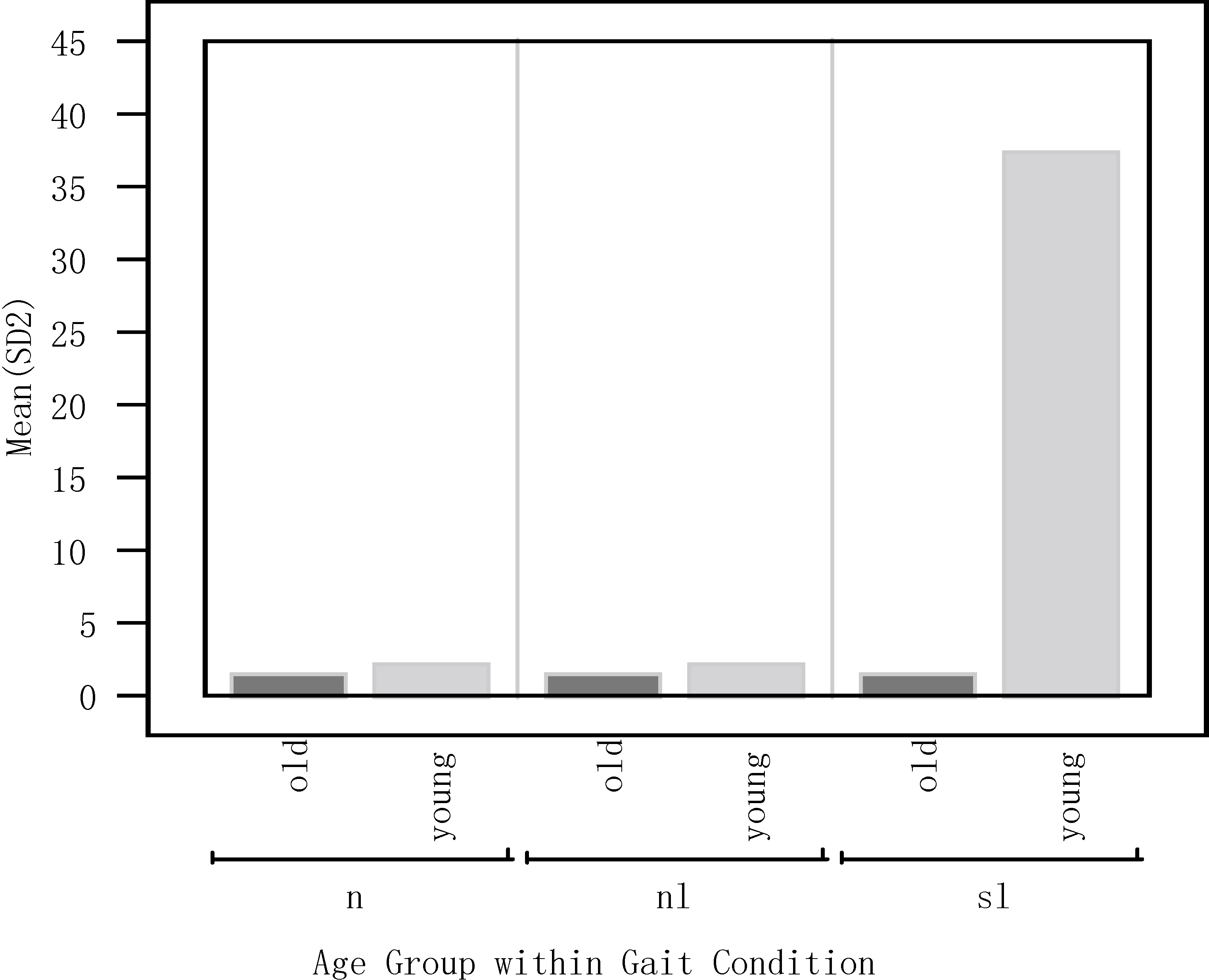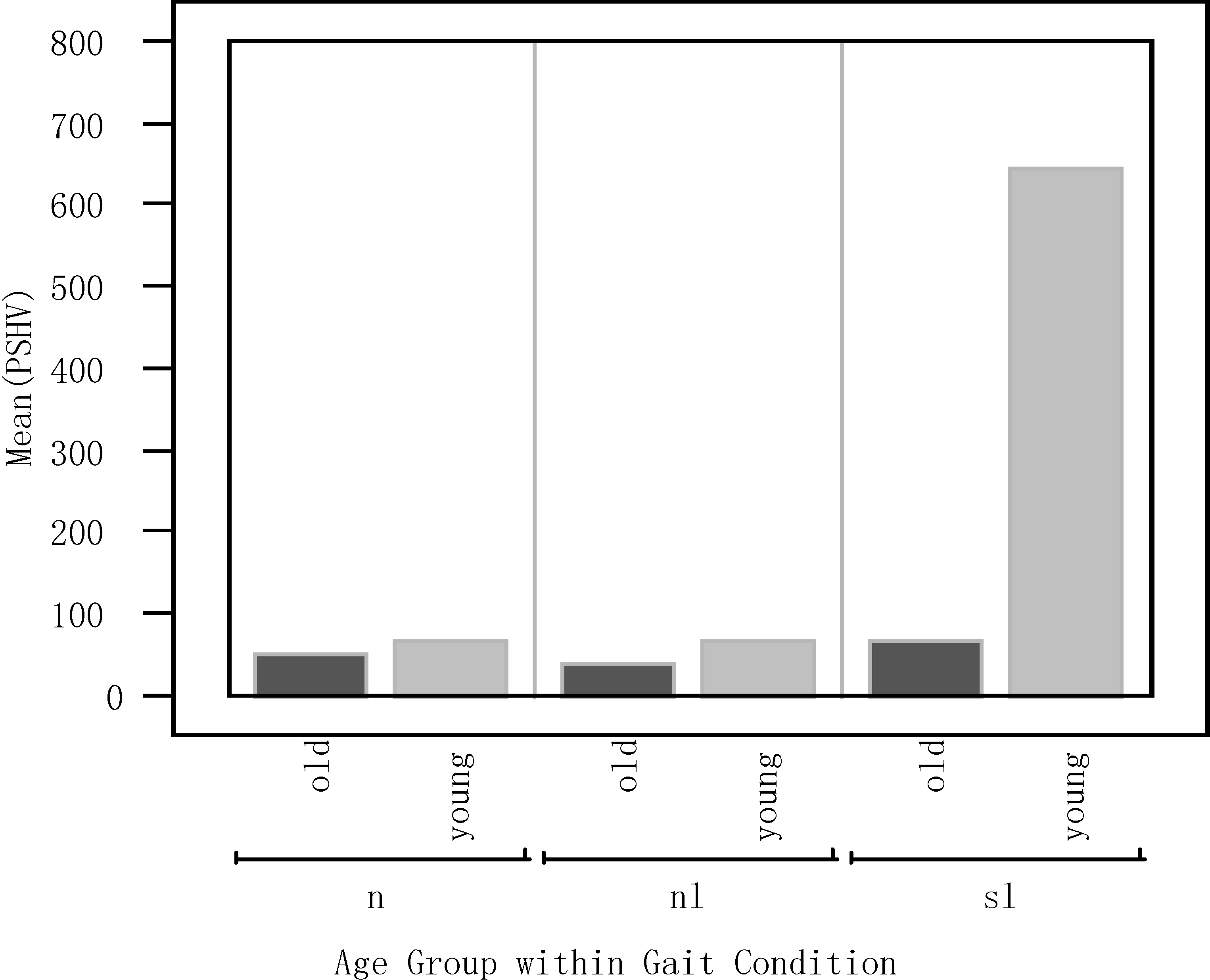Effect of load carrying on required coefficient of friction
Abstract
BACKGROUND:
A load carrying task was identified as a major factor leading to slip and fall injuries such as overexertion and bodily reaction. Holding a load in front of the body while walking would shift the whole body center-of-mass to the front, loading additional rotational torque at the foot-ground contact.
OBJECTIVES:
The present study evaluated if carrying a load would increase the likelihood of slip initiation and the slip severity.
METHODS:
Eleven young and 10 older adults participated in the present study. A dry surface or a slippery surface was introduced while walking. Slip distance, peak sliding heel velocity, heel contact velocity, and required coefficient of friction were measured to test the study hypotheses.
RESULTS:
The results showed that significant main effects were found in slip distance, and peak sliding heel velocity and no main effect were found in heel contact velocity and required coefficient of friction.
CONCLUSION:
In conclusion, younger adults were found to slip longer and faster on the slippery surface while carrying a load. On the contrary, the older adults employed a safety-centered gait adaptation while carrying, to maintain slip initiation and severity characteristics at the same level as normal walking. Furthermore, light load carriage at 10% of body weight was suggested as a safe task for the elderly.
1.Introduction
With advancing age, there is an increasing incidence of slip-induced fall injuries [1, 2, 3]. A High percentage of disabling victims from fall accidents were over the age of 55 years old [4]. The most of the slip-induced falls take place if the frictional force (F
A load carrying task was identified as a major factor leading to slip and fall injuries such as overexertion and bodily reaction [10]. Holding a load in front of the body while walking would shift the whole body center-of-mass to the front, loading additional rotational torque at the foot-ground contact [11]. Increasing the rotational torque during the heel contact phase of the gait may increase friction demand and frequency of slip-induced falls.
In the current study, effects of load carrying tasks and its relationship to the likelihood of slip-induced falls were examined. Aging factor was also evaluated to determine its effect on the initiation process of slip and fall accidents. An explicit assumption of current study was that quantification of biomechanical parameters associated with slip and fall accidents was an important and critical first step towards identifying significant factors influencing the outcome of slips and falls among older adults, especially when carrying a load. Understanding these critical factors will help focus our attention towards developing the most relevant intervention strategies (e.g., development of risk assessment methods and job evaluations) associated with older adults’ slip and fall accidents in workplaces.
Specifically, current study hypothesized that 1) Carrying a load would increase the likelihood of slip initiation, which was characterized by increased heel contact velocity (HCV) and required coefficient of friction (RCOF); 2) Carrying a load would also increase the slip severity, which was indicated by increased slip distance (SD) and peak sliding heel velocity (PSHV). Additionally, age-related differences would be reflected by different degrees of responses to the slipper surface.
2.Method
Eleven young and 10 old healthy adults participated in the current study. Informed Consent was approved by the Institute Review Board and was obtained from all participants before any data collection. Participants’ information was summarized in Table 1.
Table 1
Participants’ information summary
| Age group | Age | Height | Weight | ||||
|---|---|---|---|---|---|---|---|
| Min | Mean | Max | Mean | SD | Mean | SD | |
| Old | 70 | 73.5 | 88 | 165.50 | 7.84 | 73.67 | 11.38 |
| Young | 19 | 23 | 27 | 171.79 | 6.00 | 76.92 | 10.13 |
Prior to performing the walking experiments, participants were fitted with standardized laboratory shoes in order to minimize possible variations due to footwear. Retro-reflectors were attached to the anatomically significant body positions [12]. The walking experiment involved participants to walk across a track embedded with two force platforms (F1 and F2, AMTI OR6-7-1000, AMTI, MA, USA), while wearing a fall arresting harness attached to an arresting rig for safety (Fig. 1). In order to obtain realistic unexpected slip and fall data, slippery surface (covered by oil) was hidden from the participants via a movable floor (F2). The movable floor was constructed to allow exchanges between oily floor and non-oily floor. Additionally, to reduce the visual effect of floor materials, the color and contrast for both the slippery and non-slippery floor materials were similar.
Figure 1.
Schematic diagram of the Laboratory.

During the experiment, participants were instructed walk across the regular vinyl surface (dry surface) for 10 minutes with and without the load (an externally padded container [46 cm
Independent variables for the current study included age groups (2 levels: young and old) and floor-load conditions (3 levels: dry(n), dry_w_load(nl), oil_w_load(sl)). Dependent variables include horizontal heel contact velocity, friction demand, slip distance 1 and 2, peak sliding heel velocity [9]. A computer algorithm was written in Matlab to objectively determine dependent variables. The aging effect and floor-load conditions were evaluated using two-way repeated measures analyses of variance (ANOVA). For these analyses, floor and load, where applicable, were treated as a within-subjects effect, while age was a between-subjects effect. Effects were considered significant when
3.Results
3.1SD1 (Slip Distance 1)
Floor effect on SD1 (Table 2, Fig. 2) was found to be significant (F(2,33.4)
Table 2
Mean and standard deviation of SD1 (mm)
| Age group | |||
|---|---|---|---|
| Old | Young | ||
| Floor condition | Dry (n) | ||
| dry_with_load (nl) | |||
| oil_with_load (sl) | 5.52 (9.05) | ||
Figure 2.
Mean of SD1 (mm).

3.2SD2 (Slip Distance 2)
Both floor effect (F(2,33.5)
Table 3
Mean (SD) of SD2 (mm)
| Age group | |||
|---|---|---|---|
| Old | Young | ||
| Floor condition | Dry (n) | 1.55 (0.39) | 2.1 (0.48) |
| dry_with_load (nl) | 1.45 (0.87) | 2.26 (0.73) | |
| oil_with_load (sl) | 1.55 (1.02) | 37.46 (48.63) | |
Table 4
Mean (SD) of PSHV (mm/s)
| Age group | |||
|---|---|---|---|
| Old | Young | ||
| Floor condition | Dry (n) | 48.67 (11.61) | 66.59 (12.17) |
| dry_with_load (nl) | 40.12 (12.22) | 68.49 (15.6) | |
| oil_with_load (sl) | 64.95 (32.78) | 643.67 (786.64) | |
Figure 3.
Mean of SD2 (mm).

3.3PSHV (Peak Sliding Heel Velocity)
PSHV (Table 4, Fig. 4) was found to be significantly affected by both floor condition (F(2,33.4)
3.4HCV (Heel Contact Velocity) and RCOF (Required Coefficient of Friction)
No difference in either HCV or RCOF was supported by the current study (Tables 5 and 6). This finding suggested that the friction demand by both younger and older group was similar across all the floor conditions. Additionally, obvious slips (10 cm or longer) were observed in 5 out of 11 younger participants, walking on the oil surface when carrying a load. In the contrary, no obvious slip event was found in all the older participants.
Table 5
Mean (SD) of RCOF
| Age group | |||
|---|---|---|---|
| Old | Young | ||
| Floor condition | Dry (n) | ||
| dry_with_load (nl) | |||
| oil_with_load (sl) | |||
Table 6
Mean (SD) of HCV (mm/s)
| Age group | |||
|---|---|---|---|
| Old | Young | ||
| Floor condition | Dry (n) | 894.52 (175.97) | 762.46 (207.65) |
| dry_with_load (nl) | 750.42 (444.03) | 857.31 (328.06) | |
| oil_with_load (sl) | 664.02 (445.96) | 941.73 (476.93) | |
Figure 4.
Mean of PSHV (mm/s).

4.Discussions
The objective of current study was to investigate the load carrying effect on kinematic gait parameter associated with slip and fall. Specifically, variables representing slip initiation (HCV and RCOF) and slip severity (SD and PSHV) were tested between different age groups and among different floor conditions.
Younger individuals were found to be highly affected by slippery surface while carrying a load. Significant higher SD and PSHV was found in slip-with-load condition only for the younger group. This finding indicated that younger individuals tended to slip longer and faster, which exposed them to higher risks of slip-induced fall accidents. Meanwhile, no SD and PSHV difference were found between normal-dry and dry-with-load conditions. Similar findings associated other gait parameters were also observed by previous researchers. The load carrying effect were significantly present on stride length on the slippery surface [13], but not on dry surfaces [14]. A study investigated different load level effect on heel velocity (HV) and found no load carrying effect across all the load levels for the dry surfaces [15].
Though slip severity was high for the younger group on the slippery surface, slip initiation characteristics for the younger group remain unaffected by different floor conditions. No significant floor condition effect on RCOF and HCV was found for the younger group. This finding suggested that load carrying would not change the initiation phase of slip and fall accidents. Further, load carriage (10% of body weight in the current study) was proposed to benefit younger group on slippery surface from the slip initiation perspective.
To accommodate the total weight increase induced by load carriage, the elderly adapted their gait pattern to favor safety priority. Results from the current study showed that there was no significant floor condition effect on all the parameters in the current study. Meanwhile, the SD and PSHV were found to be significantly lower for the elderly than their younger counterparts on the slippery surface while carrying a load. This suggested the elderly actively adjusted their gait pattern to maintain the likelihood of slip initiation and severity at the same level of normal walking. Such adjustment by the elderly may be due to the fear of falling [16, 17].
Light load carriage level would not expose the elderly to higher risks of slip and fall accidents. All the participants in the current study were instructed to front carry 10% of their body weight. Such weight level can be considered as a light load, considering that 40% of body weight was recommended as the maximum carry weight [18]. The study investigated load level effect for the younger group and found only load level at 40% of body weight was found to have a significant effect on the stride length [15]. Together with findings associated with the elderly in the current study, it can be concluded that light load carrying was still a safe task for the elderly.
There were several limitations existing in the current study. First, to ensure the natural gait characteristic, walking velocity was not controlled for the participants. By controlling the identical walking speed or comparing floor condition related speed alterations, a future study would be able to find out the details about safety-centered gait adaptation by the elderly, and to evaluate such adaptation in terms of long-term benefit for the elderly. Second, means of load carrying in the current study was fixed to front carry 10% of body weight against the participants’ body. Further research investigating different load carrying approaches and weight levels would possibly provide a recommendation on most appropriate carrying method and maximum weight level, from the consideration of minimizing slip-induced fall accidents.
5.Conclusions
In conclusion, younger adults were found to slip longer and faster on the slippery surface while carrying a load. On the contrary, the older adults employed a safety-centered gait adaptation while carrying, to maintain slip initiation and severity characteristics at the same level as normal walking. Furthermore, light load carriage at 10% of body weight was suggested as a safe task for the elderly.
Conflict of interest
None to report.
References
[1] | Courtney TK, Sorock GS, Manning DP, Collins JW, Holbein-Jenny MA. Occupational slips, trip, and fall-related injuries-can the contribution of slipperiness be isolated, Ergonomics. (2001) ; 44: (13): 1118-1137. |
[2] | Nicklett EJ, Taylor RJ. Racial/Ethnic predictors of falls among older adults: the health and retirement study, J Aging Health. (2014) ; 26: : 1060-75. |
[3] | Burns ER, Stevens JA, Lee R. The direct costs of fatal and non-fatal falls among older adults – United States, J Safety Res. (2016) ; 58: : 99-103. |
[4] | Courtney TK, Webster BS. Antecedent factors and disabling occupational morbidity-insights form the new BLS data, American Industrial Hygiene Association Journal. (2001) ; 62: : 622-632. |
[5] | Kim S, Lockhart TE. Effects of 8 week-balance training or weight training for the independently living elderly on the outcomes of induced slips, International Journal of Rehabilitation Research. (2010) ; 33: (1): 49-55. |
[6] | Hanson JP, Redfern MS, Mazumdar M. Predicting slips and falls considering required and available friction, Ergonomics. (1999) ; 42: (12): 1619-1633. |
[7] | Seo J, Kim S. Asymmetrical slip propensity: required coefficient of friction, J of Neuroengineering and Rehabilitation. (2013) ; 10: (1): 84. DOI: 10.1186/1743-0003-10-84. |
[8] | Seo J, Kim S. Prevention of potential falls of elderly healthy women: gait asymmetry, Educational Gerontology. (2014) ; 40: (2): 123-137. |
[9] | Lockhart T, Kim S. Relationship between hamstring activation rate and heel contact velocity: Factors influencing age-related slip-induced falls, Gait and Posture. (2006) ; 24: : 23-34. |
[10] | Bureau of Labor Statistics (BLS). USA: US. Department of Labor Website; 2000. Available from: http//www.bls.gov/special.requests/ocwc/oshwc/cfoi/cftb135.pdf. |
[11] | Rohlmann A, Zander T, Graichen F, Schmidt H, Bergmann G. How does the way a weight is carried affect spinal loads, Ergonomics. (2014) ; 57: (2): 262-270. doi: 10.1080/00140139.2014.887789. |
[12] | Grönqvist R, Abeysekera J, Gard G, Hsiang SM, Leamon T, Newman D, Gielo-Perczak K, Lockhart TE, Pai YC, Human-centred approaches in slipperiness measurement, Ergonomics. (2001) ; 44: (13): 1167-1199. |
[13] | Leamon TB, Li KW. Load carrying and slip length. Human Factors Society. Proceedings of the 35 |
[14] | Kinoshita H. Effects of different loads and carrying systems on selected biomechanical parameters describing walking gait, Ergonomics. (1985) ; 28: : 1347-1362. |
[15] | Myung R, Smith JL. The effect of load carrying and floor contaminants on slip and fall parameters, Ergonomics. (1997) ; 40: (2): 235-246. |
[16] | Chandler JM, Duncan PW, Sanders L, Studenski S. The fear of falling syndrome: Relationship to falls, physical performance, and activities of daily living in frail older persons, Topics in Geriatric Rehabilitation. (1996) ; 11: : 55-63. |
[17] | Lawrence RH, Tennstedt SL, Kasten LE, Shih J, Howland J, Jette AM. Intensity and correlates of fear of falling and hurting oneself in the next year: Baseline findings from a Royal Center fear of falling intervention, Journal of Aging and Health. (1998) ; 10: : 267-286. |
[18] | Cathcart EP, Richardson DT, Campbell W. On the maximum load to be carried by the soldier, Journal of Royal Army Medical Corps. (1923) ; 40: : 435-443. |




